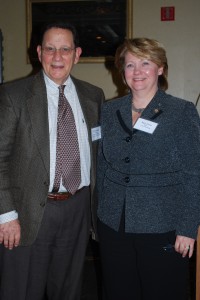
What do trains and farms have in common? They are among the elements that can contribute to a brighter economic future for the Hudson Valley.
That was the consensus of experts assessing smart growth in the region at a conference of officials and planners in Fishkill.
The Hudson Valley finds itself uniquely situated to benefit economically from trends in public policy and lifestyle collectively referred to as smart growth, especially in light of new state laws that took effect in September.
But the question remains whether a far-flung region without a centralized decision-making body can cooperate and create a synergy for regional prosperity as opposed to building isolated developments that sprawl across the landscape in ways that harm the regional tax base and may stifle the economy.
The challenge and opportunity of smart growth were addressed at the Hudson Valley in the 21st Century, Smart Growth and Regional Cooperation, organized by the Westchester based nonprofit group Historic Hudson River Towns, and held Dec. 8 at the Fishkill Holiday Inn.
The conference laid out the potential impacts of the state”™s Smart Growth Policy Infrastructure Act.
“Smart Growth is an attempt to balance in local and state planning the interests of job creation, environmental stewardship and social equity,” Paul Beyer, director of Smart Growth of the Governor”™s Office, told the conference. “That”™s the key to the movement, to balance those three aspects of community planning.”
Glenn Gidaly, senior project manager for Barton & Loguidice P.C., highlighted the smart-growth act that requires state agencies that are funding projects to meet 10 goals aimed at focusing development around already existing infrastructure.
The Hudson Valley with its centralized towns and city centers, hamlets and railroad lines and existing highways is ideally positioned to take advantage of the new law. It requires key state entities, including the Department of Transportation, the Port Authority of New York and New Jersey, the Department of Education, and the Empire State Development Corp. to focus their infrastructure spending in developed areas.
Infrastructure projects will be mandated to protect environmental resources, foster compact, mixed-use development, and reduce dependence on automobiles. Agency heads can override the smart-growth criteria only if they issue a written justification of their decision.
But the potential advantages of smart growth for the Hudson Valley are diluted by the sprawling nature of the region, with cities from Yonkers to Kingston and towns from Dobbs Ferry to Rhinebeck, spread among five counties, all competing for increasingly scarce municipal resources and investment funds.
Without a centralized body for decision-making, joint planning will be a key factor in determining how far-reaching smart-growth principles are in guiding development in the region. The Hudson Valley is projected to have 100,000 residential units developed over the upcoming years. While the recession may have slowed the time frame on which those units are built, planning officials from Ulster, Dutchess and Orange counties said that as currently configured those units would largely be built in sprawling developments as opposed to centered in existing population centers. And they said 40,000 of those units should be affordable, but no such plans are being made.
The county planners discussed how they agreed that voluntarily signing onto development compacts connected with the Hudson River Greenway serves as a baseline for guiding projects into smart growth outcomes. And they said the three counties are collaborating in various ways, through coordinating projects using federal transportation funding, in amounts ranging from tens to hundreds of millions of dollars. “In counties our size, that is real money,” said John Clarke of the Dutchess County Planning Department.
But in the recent past, all three showed how growth in their counties has not abided by smart-growth principles and said the region stands to lose a great deal of its quality of life if that trend continues. “Smart growth is the exact opposite of what we”™ve been doing the last fifty years,” said Clarke. “If we don”™t change the basic development pattern of Dutchess County, we”™re going to lose everything we love.”


















Comments 1